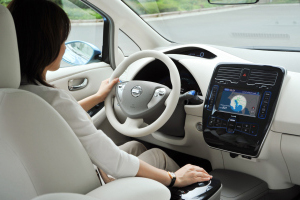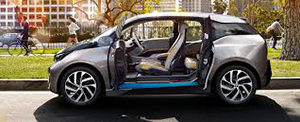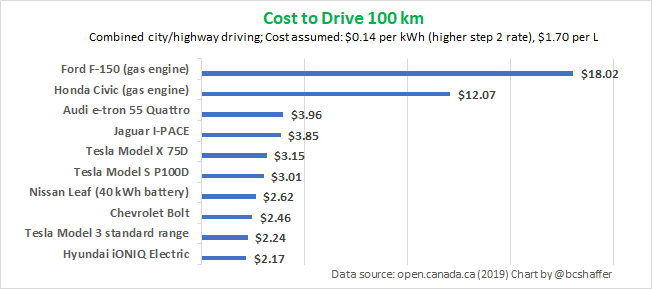In addition to the information provided below, you can also obtain personalized advice for your particular situation. Details here.
Electric Driving Range Purchase Cost Operating Cost Over Air Updates The Environment Home Charging MURB Charging Passenger Vehicles Pickups & Vans Used Vehicles Dealers Nissan Leaf
Nissan Leaf
Electric vehicles are very quiet and without the vibration generated by a gas engine. The result is a feeling of floating along in silence. If you like listening to music, then you will be pleasantly surprised at how much better it sounds.
Because the vehicle makes no noise, there is a danger to pedestrians used to hearing gas engine vehicles coming their way. Therefore electric vehicles generally emit a soft artificial sound when travelling under 25 km per hour as well as a beeping sound when moving in reverse.
There are no gears or transmission. When you are stopped, the engine is stopped - no engine idling using up fuel and creating noise and vibration. Without gear changing, acceleration is rapid enough to push you back in your seat.
Most electric vehicles can cruise comfortably at highway speeds — silently.
For those wanting to try out the electric vehicle experience for a few days, the car rental agency Zerocar, located in Richmond, rents the Tesla Model X Yoke, Model 3 Performance and Model Y performance. Plug-in Richmond members receive a 5% discount.
 Tesla Model S
Tesla Model S
Most Richmond residents probably drive an average of 30 km per day. However, they would like to be able to drive an electric vehicle 80 km without recharging. The distance from Richmond Centre to Canada Place in downtown Vancouver is 16 km. Two return trips downtown in one day with an extra margin for safety would be 80 km, well within the range of the electric vehicles listed here.
Most owners charge their electric vehicles overnight at home. When the return trip exceeds the range of the vehicle, owners want to recharge the vehicle at the destination in less than an hour for the trip home. This requires an electric vehicle with Level 3 charging capability and a Level 3 public charging station at the destination which can usually recharge the battery to 80% capacity in a half hour. While a rapidly increasing number of Level 3 charging stations are being installed, Level 2 charging is more widely available and takes about 4 hours for most electric vehicles with a fully depleted battery.
The EPA combined city/highway electric range rating shown in the vehicle listing is reduced for highway only driving at 110 km/h by about 15%. Climbing mountains also reduces range although about 70% is recovered when descending through regenerative braking.
The common recommendation is to stop for at least 15 minutes to stretch every two hours of driving whether the vehicle needs refuelling or not. Level 3 recharging to 80% battery capacity takes a half hour or less. Recharging slows down significantly for the remaining 20% so most drivers charge to 80%.
Assuming a two hour driving time over flat terrain at 110 km/h, 85% of the EPA combined city/highway range and only using 80% of the battery capacity results in a required EPA combined city/highway range as shown in the vehicle listing of 363 km. A three hour driving time would increase the required range as shown in the listing to 525 km. As explained below, climbing mountains extra battery capacity, but these amounts of range are adequate to reach Seattle, Whistler and Hope without recharging.
The chart below shows the average adjusted electric range required for typical destinations from Richmond by increasing the actual distance from Richmond to account for a highway speed of 110 km/h and the total mountain climbing and descent. An additional 5% cushion has also been added to allow for individual vehicle variation from the average and a reserve. Some drivers may want a larger reserve. The adjusted electric range required for a particular destination can be directly compared to the EPA electric range ratings in the vehicle listing. See the note below the chart for an explanation of the range calculations.
No reduction in range is included in the chart for use of the vehicle's heating and air conditioning systems and loss of battery efficiency outside the ideal outside operating temperature of 15-25°C. Use of these systems and loss of battery efficiency will reduce range on average by 10% for an outside temperature of 5°C or 30°C.
There are level 3 charging facilities in Hope that in 40 minutes or less can recharge the 206 km of range used in getting to Hope. The range requirements from Hope to Merritt, Kamloops and Kelowna are shown for vehicles with batteries large enough to reach these destinations without further recharging.
| Destinations from Richmond | Required Range to Destination | Required Range Return Trip | Actual Distance | Total Climb | Total Descent |
|---|---|---|---|---|---|
| White Rock | 52 km | 52 km | 40 km | 213 m | 213 m |
| Bellingham | 103 km | 103 km | 78 km | 636 m | 636 m |
| Seattle | 288 km | 288 km | 220 km | 1,555 m | 1,555 m |
| Sechelt | 97 km | 97 km | 75 km | 925 m | 925 m |
| Squamish | 103 km | 103 km | 80 km | 905 m | 905 m |
| Whistler | 199 km | 183 km | 136 km | 1,941 m | 1,275 m |
| Langley | 58 km | 58 km | 45 km | 197 m | 191 m |
| Abbotsford | 105 km | 104 km | 80 km | 456 m | 418 m |
| Hope | 206 km | 205 km | 160 km | 690 m | 649 m |
| Destinations from Hope | Required Range to Destination | Required Range Return Trip | Actual Distance | Total Climb | Total Descent |
|---|---|---|---|---|---|
| Merritt | 180 km | 166 km | 120 km | 1,549 m | 944 m |
| Kamloops | 305 km | 297 km | 215 km | 2,952 m | 2,628 m |
| Kelowna | 341 km | 333 km | 240 km | 3,423 m | 3,080 m |
Note: As a rough guide, the EPA equivalent range for highway only driving at 100 kilometers per hour (km/h) is 90% of the electric range shown in the vehicle listing. This drops to 85% for highway driving at 110 km/h. Above that speed, tire size, headwinds, weight of occupants, open windows and aerodynamic design influence range, but it is generally 75-80% at 120 km/h. Vehicles with all-wheel-drive dual motors achieve 80-85% at 120 km/h by turning off one of the motors until it is needed for acceleration. Mountain terrain reduces a vehicle’s range by about 10 km for every 300 m of climb in elevation. Regenerative braking will recover about 7 km of range for every 300 m of descent. Note that if the vehicle has a full battery at the mountain top, it will not be able to absorb the power from regenerative braking on the way down.
 BMW i3
BMW i3
Electric vehicles are more expensive to purchase, but less expensive to operate. The higher purchase cost can be recovered in as little as 4 years. See Operating Cost below.
A number of the fully electric vehicles with a range over 350 km have a net selling price below $40,000 before taxes and after deducting the federal and BC rebates from the Manufacturer's Suggested Retail Price (MSRP). Several of the models with a range of 480 km or more sell for under $50,000 after rebates. (Federal and BC rebates paused until further notice.)
The complete vehicle list is here. Click on the column headings to order the list. For most electric vehicles, the MSRP is a starting point for negotiation as it is with most gas engine vehicles. However due to a shortage of electric vehicles, discounts will be rare on popular models.
Assuming that a home charging station is being installed, the cost should be added to the purchase cost of the vehicle. See below.
Used electric vehicles, particularly the 2015 - 2017 Nissan Leaf, Kia Soul EV and BMW i3, are available in the $20,000 - $25,000 range. Details here. There are links to used electric vehicle sources on our Dealers page.
There is a Federal Government rebate of $5,000 after tax for the purchase of a plug-in electric vehicle with an electric range of 50 km or more and $2,500 if the range is less. (Federal rebates paused until further notice.) That rebate has not been deducted from the MSRP shown on the list. The manufacturer's suggested retail price (MSRP) for the base model must be under $55,000 before delivery charges. More expensive trim models must not exceed $65,000. In the case of SUVs, pickups and vans, the base model must be under $60,000 and more expensive trim models must not exceed $70,000. Details here.
For individuals, there is a BC Government rebate to a maximum of $4,000 for the purchase of a plug-in electric vehicle with an electric range of 85 km or more and a maximum of $2,000 if the range is less. (BC rebates paused until further notice.) The manufacturer's suggested retail price (MSRP) cannot exceed $50,000 for most models including SUVs and cannot exceed $70,000 for pickups and vans. The maximum rebate is reduced to one-half if individual total income for tax purposes exceeds $80,000. The maximum rebate is reduced to one-quarter if individual total income exceeds $90,000. There is no rebate if individual total income exceeds $100,000. Before purchasing the vehicle, you must apply online for a rebate authorization that is sent to you by email. This can take up to 3 weeks. You should apply before you decide which vehicle to buy. The authorization is good for one year. Individuals can no longer receive a second rebate if they purchase another EV. Details here.
For businesses and non-profits, the BC Government rebate is $3,000 for the purchase of a plug-in electric vehicle with an electric range of 85 km or more and $1,500 if the range is less. (BC rebates paused until further notice.) The manufacturer's suggested retail price (MSRP) cannot exceed $50,000 for most models including SUVs and cannot exceed $70,000 for pickups and vans. It is not necessary to apply in advance. Details here.
The Federal and BC rebates have not been deducted from the MSRP shown on the list. The vehicle dealer will deduct them at time of purchase and claim them from the governments.
As with gas engine vehicles, purchase cost negotiation varies greatly depending on the individual purchaser, the dealer and the particular day. It is usually best to first obtain a quote including all desired accessories, extras and tax. From this total, the BC Government rebate and the manufacturer's rebate, if any, are deducted. The dealer can then be asked what additional discount can be offered. The purchaser can offer somewhat less and see what happens. However due to a shortage of electric vehicles, discounts will be rare on popular models.
Both the BC and Federal goverments have a luxury vehicle tax. The BC tax increases the PST from the usual 7% for vehicles under $75,000 to 8% for vehicles under $76,000, 9% for vehicles under $77,000, 10% for vehicles under $125,000, 15% for vehicles under $150,000 and 20% for vehicles $150,000 and over. The Federal luxury tax is in addition to the 5% GST. It is 20% of the portion of the vehicle price that exceeds $100,000 for vehicles under $200,000 and 10% of the total vehicle price for vehicles $200,000 and over. The PST is calculated first, then the Federal luxury tax on the amount before the PST and then the 5% GST on the amount including the PST and the luxury tax. A vehicle price of $130,000 before taxes becomes $163,275 after taxes.

The savings in operating cost comes from both the lower cost of electricity compared to gas and the lower maintenance cost due to the far lesser number of moving parts and fluids. The savings on gas are shown in the above chart. A Nissan Leaf driving 15,000 km per year would save over $1,400 annually on gas over a Honda Civic. According to the Canadian Automobile Association, the savings on maintenance would be at least $500 per year for the first 5 years and significantly more than that in the years following.
The Nissan Leaf also receives both the BC $4,000 purchase incentive and the $5,000 federal incentive. The total savings for the first 5 years would therefore be $17,500.
A typical new electric vehicle warranty guarantees that the battery's capacity will not drop below 70% in the first 8 years or 160,000 km. Aside from defective batteries replaced under warranty, replacement of a battery is extremely rare. Consumer Reports estimates that most batteries will last on average 17 years and 320,000 km (18,800 km per year) which is generally the life of the vehicle. Tesla batteries taken from taxis driven that far still have a capacity exceeding 85%. Any battery refurbishment cost would be offset by the considerable savings on maintenance over the life of the vehicle.
There is very little maintenance required since there are neither oil changes nor engine, transmission and exhaust system issues. The electric motor is used to slow the vehicle through regenerative braking and the brakes only bring it to a full stop. With so little use, brake pads are generally expected to last 150,000 km. Regenerative braking also has the advantage of charging the battery while the vehicle is slowing.
 TP-Link RE220 range extender
TP-Link RE220 range extender
Tesla has been the pioneer in developing the ability to update vehicle software and firmware by transmitting updates over the air rather than requiring that the vehicle be brought to a service centre. Almost all major manufacturers are actively devloping similar capabilities, initially only for updating maps and infotainment systems. Although Tesla can transmit updates using the cellular network if necessary, vehicle owners are required to provide connectivity to a high bandwidth home WiFi network.
It may be difficult to provide high speed connectivity in a garage or parking space. If so, a WiFi range extender should be installed. These are plugged into a normal electrical outlet and boost the low bandwidth signal. They usually work best when placed higher than an electrical outlet near the floor. The TP-Link RE220 range extender, although an old model, is a low cost option ($35) available from Best Buy and Amazon. If the garage has a door opener plugged into a ceiling outlet, using the same outlet for the range extender may be ideal.

For those interested in reducing their household's direct greenhouse gas emissions, switching to an electric vehicle has by far the greatest impact. BC Government statistics show that household vehicle use accounts for 44.6% of household GHG emissions while household space heating and cooling is responsible for 16.6% and water heating for 8%. Air travel accounts for 13.1%; bus and rail for 2.4%. Even using a gas engine vehicle 20% of the time for longer trips would still save 35.7% of of household GHG emissions by switching to an electric vehicle for daily travel.
According to a 2014 City of Richmond Report, personal automobile use in Richmond contributes 41% of community greenhouse gas emissions. According to the BC Government, new 2015 model gas engine vehicles emit about 3 tonnes of greenhouse gases (GHG) annually. Electric vehicles emit none.
In some jurisdictions, electricity is generated using coal or other fossil fuels which generate GHG and lower somewhat the reduction in emissions from switching to electric vehicles. However in BC, our electricity is generated by hydro power which does not generate GHG and gives us the full benefit from using electric vehicles.
The disposal of motor oil used in gas engines and transmissions can harm the environment. Motor oil picks up a variety of hazardous contaminants including lead, cadmium, chromium, arsenic, dioxins, benzene and polycyclic aromatics. Electric vehicles do not require motor oil nor use toxic gas additives.
There is a detailed 2019 environmental impact report from Tesla on the lifecycle emissions of its vehicles and the manufacture, use and recycling of its batteries. Batteries with reduced capacity can be used in other energy storage applications or they can be ground up and over half of their components that are metals can be recycled into the manufacture of new batteries.